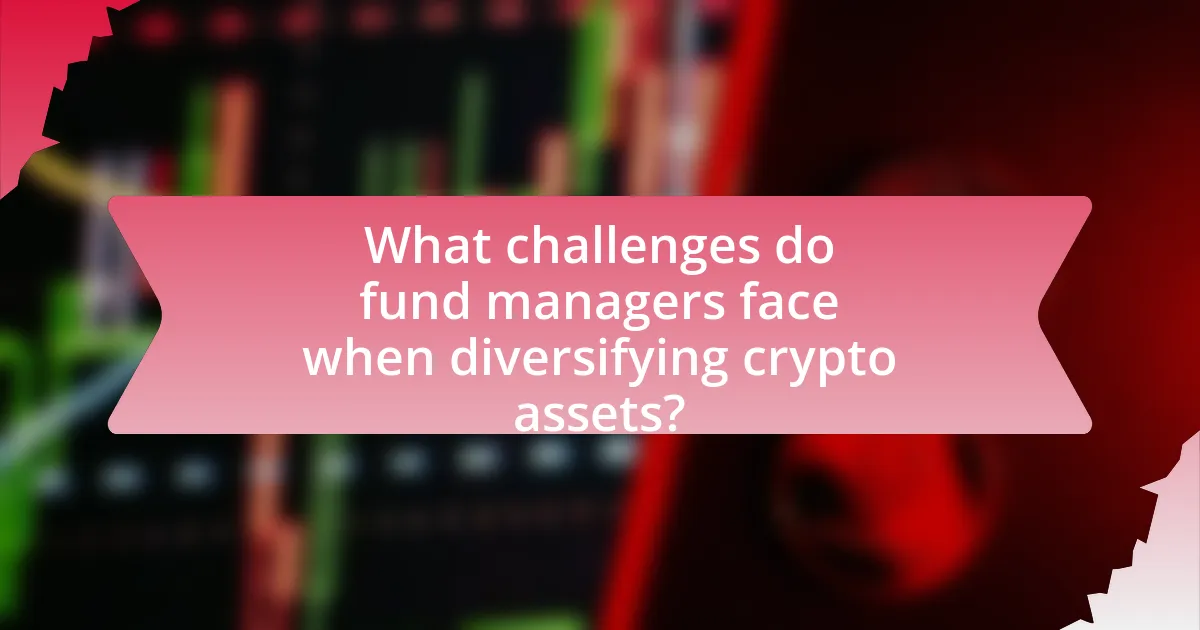Diversifying crypto assets is a strategic approach that involves spreading investments across various cryptocurrencies to minimize risk and enhance potential returns. This article outlines the importance of diversification for fund managers in the highly volatile cryptocurrency market, detailing how it mitigates market, liquidity, and concentration risks. Key principles of effective diversification, including asset allocation, sector diversification, and geographic considerations, are discussed, along with strategies for balancing established and emerging cryptocurrencies. Additionally, the article addresses the challenges fund managers face, such as regulatory compliance and security risks, while providing best practices and tools to optimize diversification efforts for improved portfolio performance.

What is Diversifying Crypto Assets?
Diversifying crypto assets involves spreading investments across various cryptocurrencies to reduce risk and enhance potential returns. This strategy mitigates the impact of volatility associated with individual cryptocurrencies, as different assets may respond differently to market conditions. For instance, a portfolio that includes Bitcoin, Ethereum, and smaller altcoins can balance the overall performance, as historical data shows that while Bitcoin may experience significant price fluctuations, other assets may remain stable or even appreciate. Diversification is a fundamental principle in investment management, supported by the Modern Portfolio Theory, which emphasizes that a diversified portfolio can achieve higher returns for a given level of risk.
Why is diversification important for fund managers in the crypto space?
Diversification is crucial for fund managers in the crypto space because it mitigates risk and enhances potential returns. The cryptocurrency market is highly volatile, with significant price fluctuations that can lead to substantial losses. By spreading investments across various cryptocurrencies and related assets, fund managers can reduce the impact of poor performance from any single asset. For instance, during the market downturn in 2018, diversified portfolios that included a mix of established cryptocurrencies like Bitcoin and emerging altcoins experienced less severe losses compared to concentrated investments. This strategy not only protects capital but also positions fund managers to capitalize on different growth opportunities within the rapidly evolving crypto landscape.
What risks does diversification mitigate in crypto asset management?
Diversification in crypto asset management mitigates several key risks, primarily market risk, liquidity risk, and concentration risk. By spreading investments across various cryptocurrencies, fund managers can reduce the impact of price volatility associated with individual assets, as evidenced by the fact that Bitcoin’s price can fluctuate significantly, while other assets may remain stable or even increase in value. Additionally, diversification helps address liquidity risk, as some cryptocurrencies may have lower trading volumes, making them harder to sell without affecting the price. By holding a mix of assets, managers can ensure they have more liquid options available. Lastly, concentration risk is minimized since investing heavily in a single asset can lead to substantial losses if that asset underperforms; diversification allows for a more balanced portfolio that can withstand downturns in specific assets.
How does diversification enhance potential returns for fund managers?
Diversification enhances potential returns for fund managers by spreading investments across various assets, which reduces risk and increases the likelihood of capturing gains from different market segments. When fund managers diversify their portfolios, they mitigate the impact of poor performance from any single asset, as losses in one area can be offset by gains in another. For instance, a study by the CFA Institute found that a diversified portfolio can reduce volatility by up to 30%, allowing fund managers to achieve more stable returns over time. This strategic allocation not only protects against market downturns but also positions fund managers to benefit from the growth of multiple asset classes, ultimately leading to improved overall performance.
What are the key principles of diversifying crypto assets?
The key principles of diversifying crypto assets include spreading investments across various cryptocurrencies, understanding market correlations, and assessing risk tolerance. Spreading investments helps mitigate the impact of volatility in any single asset, as evidenced by the fact that Bitcoin’s price can fluctuate significantly, while altcoins may behave differently under similar market conditions. Understanding market correlations allows investors to choose assets that do not move in tandem, reducing overall portfolio risk. Additionally, assessing risk tolerance ensures that the diversification strategy aligns with the investor’s financial goals and capacity to absorb potential losses. These principles collectively enhance the potential for stable returns while minimizing risks associated with the highly volatile cryptocurrency market.
How do different asset classes within crypto contribute to diversification?
Different asset classes within crypto contribute to diversification by offering varying risk profiles and performance characteristics. For instance, cryptocurrencies like Bitcoin and Ethereum are often considered high-risk, high-reward assets, while stablecoins provide lower volatility and serve as a hedge against market fluctuations. By combining these asset classes, investors can mitigate risks associated with market downturns, as the performance of stablecoins may remain stable when more volatile cryptocurrencies decline. Historical data shows that during market corrections, stablecoins have maintained their value, while traditional cryptocurrencies have experienced significant price drops, thus highlighting the importance of including diverse asset classes in a crypto portfolio for effective risk management.
What role does market volatility play in diversification strategies?
Market volatility significantly influences diversification strategies by necessitating the allocation of assets across various cryptocurrencies to mitigate risk. High volatility in the crypto market can lead to substantial price fluctuations, making it essential for fund managers to diversify their portfolios to reduce exposure to any single asset’s performance. For instance, during periods of increased volatility, a well-diversified portfolio can help stabilize returns, as different assets may react differently to market changes. Historical data shows that diversified portfolios tend to exhibit lower overall risk and more consistent performance compared to concentrated investments, underscoring the importance of diversification in managing the inherent risks associated with volatile markets.

How can fund managers effectively diversify their crypto portfolios?
Fund managers can effectively diversify their crypto portfolios by allocating investments across various cryptocurrencies, including established coins like Bitcoin and Ethereum, as well as emerging altcoins. This strategy reduces risk by minimizing exposure to the volatility of any single asset. Research indicates that a diversified portfolio can enhance returns while lowering overall risk; for instance, a study by the CFA Institute found that portfolios with a mix of assets, including cryptocurrencies, can achieve better risk-adjusted returns compared to those concentrated in a single asset class. Additionally, fund managers should consider incorporating different sectors within the crypto space, such as DeFi, NFTs, and stablecoins, to further spread risk and capitalize on various market opportunities.
What strategies should fund managers consider for diversification?
Fund managers should consider strategies such as asset allocation, sector diversification, and geographic diversification for effective diversification. Asset allocation involves distributing investments across various asset classes, such as cryptocurrencies, equities, and fixed income, to mitigate risk. Sector diversification entails investing in different sectors within the cryptocurrency market, such as DeFi, NFTs, and stablecoins, to reduce exposure to sector-specific volatility. Geographic diversification involves investing in cryptocurrencies from various regions to hedge against localized market risks. These strategies are supported by research indicating that diversified portfolios tend to exhibit lower volatility and higher risk-adjusted returns, as evidenced by studies from financial institutions like Vanguard and BlackRock.
How can fund managers balance between established and emerging cryptocurrencies?
Fund managers can balance between established and emerging cryptocurrencies by allocating a percentage of their portfolio to each category based on risk tolerance and market analysis. Established cryptocurrencies, such as Bitcoin and Ethereum, provide stability and liquidity, making them suitable for a larger portion of the portfolio, often around 60-80%. In contrast, emerging cryptocurrencies can offer higher growth potential but come with increased volatility, warranting a smaller allocation of 20-40%.
This strategy is supported by historical data showing that established cryptocurrencies have lower price fluctuations compared to emerging ones, which can experience rapid gains or losses. For instance, Bitcoin’s average annual volatility has been significantly lower than that of many emerging cryptocurrencies, making it a safer investment. By continuously monitoring market trends and adjusting allocations accordingly, fund managers can effectively manage risk while capitalizing on growth opportunities in the cryptocurrency market.
What is the significance of geographic diversification in crypto assets?
Geographic diversification in crypto assets is significant because it mitigates risks associated with regulatory changes, market volatility, and economic instability in specific regions. By spreading investments across various geographic locations, fund managers can reduce the impact of adverse events in any single market. For instance, if a country enacts strict regulations on cryptocurrency trading, assets held in more favorable jurisdictions can help maintain overall portfolio stability. Additionally, data from the Cambridge Centre for Alternative Finance indicates that different regions exhibit varying adoption rates and technological advancements, which can lead to unique investment opportunities. Thus, geographic diversification enhances resilience and potential returns in the crypto asset market.
How can fund managers assess the performance of diversified crypto portfolios?
Fund managers can assess the performance of diversified crypto portfolios by utilizing key performance indicators (KPIs) such as return on investment (ROI), volatility measures, and correlation metrics among assets. ROI provides a clear percentage of profit or loss relative to the initial investment, allowing managers to gauge overall portfolio effectiveness. Volatility measures, such as standard deviation, help assess the risk associated with the portfolio, indicating how much the asset prices fluctuate over a specific period. Correlation metrics reveal how different cryptocurrencies move in relation to one another, enabling managers to understand diversification benefits and potential risks. By analyzing these KPIs, fund managers can make informed decisions to optimize portfolio performance and manage risk effectively.
What metrics should be used to evaluate the success of diversification efforts?
To evaluate the success of diversification efforts in crypto assets, fund managers should use metrics such as portfolio volatility, Sharpe ratio, and correlation coefficients. Portfolio volatility measures the degree of variation in asset prices, indicating risk levels; lower volatility suggests effective diversification. The Sharpe ratio assesses risk-adjusted returns, with higher values indicating better performance relative to risk taken. Correlation coefficients between assets reveal how asset prices move in relation to one another; lower correlations suggest successful diversification, as assets do not move in tandem, reducing overall portfolio risk. These metrics provide a comprehensive view of the effectiveness of diversification strategies in managing risk and enhancing returns.
How can fund managers adjust their strategies based on performance analysis?
Fund managers can adjust their strategies based on performance analysis by systematically evaluating the returns and risks associated with their current asset allocations. This evaluation allows them to identify underperforming assets and reallocate resources to more promising opportunities, thereby enhancing overall portfolio performance. For instance, if a specific cryptocurrency consistently underperforms against market benchmarks, fund managers may choose to reduce their exposure to that asset and increase investments in higher-performing alternatives. Historical data shows that funds that actively adjust their strategies based on performance metrics can achieve better risk-adjusted returns, as evidenced by studies indicating that dynamic asset allocation can lead to improved outcomes in volatile markets.

What challenges do fund managers face when diversifying crypto assets?
Fund managers face several challenges when diversifying crypto assets, primarily due to market volatility, regulatory uncertainty, and liquidity issues. Market volatility is significant in the cryptocurrency space, with prices often experiencing drastic fluctuations, making it difficult for fund managers to maintain a balanced portfolio. Regulatory uncertainty complicates diversification efforts, as varying regulations across jurisdictions can impact asset selection and compliance. Additionally, liquidity issues arise because not all cryptocurrencies have the same trading volume, which can hinder the ability to buy or sell assets without affecting their market price. These factors collectively create a complex environment for fund managers aiming to diversify effectively within the crypto market.
What regulatory considerations impact diversification strategies?
Regulatory considerations that impact diversification strategies include compliance with securities laws, anti-money laundering (AML) regulations, and tax implications. Fund managers must ensure that their diversification strategies adhere to the legal frameworks established by regulatory bodies such as the Securities and Exchange Commission (SEC) in the United States, which governs the offering and sale of securities, including crypto assets. Additionally, AML regulations require fund managers to implement measures to prevent illicit activities, which can influence the choice of assets for diversification. Tax implications also play a crucial role, as different jurisdictions may impose varying tax treatments on crypto assets, affecting the overall strategy and potential returns.
How do security risks affect the diversification of crypto assets?
Security risks significantly hinder the diversification of crypto assets by increasing the potential for loss and volatility. When investors perceive high security risks, such as hacking incidents or regulatory uncertainties, they may become hesitant to allocate funds across various cryptocurrencies. This reluctance can lead to a concentration of investments in a limited number of assets, undermining the fundamental principle of diversification, which aims to spread risk across a broader portfolio. For instance, the 2014 Mt. Gox hack, which resulted in the loss of approximately 850,000 Bitcoins, exemplifies how security breaches can lead to a loss of confidence in the market, prompting investors to withdraw from less secure assets and concentrate their holdings in perceived safer options.
What are the liquidity challenges associated with diversifying crypto portfolios?
Diversifying crypto portfolios presents liquidity challenges primarily due to the varying levels of market activity and trading volume across different cryptocurrencies. Many altcoins experience lower liquidity compared to major cryptocurrencies like Bitcoin and Ethereum, making it difficult to execute large trades without significantly impacting the market price. For instance, according to a report by CoinMarketCap, smaller cryptocurrencies can have trading volumes that are a fraction of those of larger coins, leading to wider bid-ask spreads and increased slippage. This disparity in liquidity can hinder fund managers’ ability to quickly enter or exit positions, ultimately affecting portfolio performance and risk management strategies.
How can fund managers overcome these challenges?
Fund managers can overcome challenges in diversifying crypto assets by implementing a robust risk management strategy. This involves conducting thorough market research to identify potential risks associated with various cryptocurrencies and utilizing tools such as diversification across different asset classes to mitigate those risks. For instance, a study by the CFA Institute highlights that diversification can reduce portfolio volatility by up to 30%, demonstrating its effectiveness in managing risk. Additionally, fund managers should leverage advanced analytics and technology to monitor market trends and adjust their strategies accordingly, ensuring they remain agile in a rapidly changing environment.
What best practices can be implemented to enhance security in diversified portfolios?
To enhance security in diversified portfolios, fund managers should implement multi-signature wallets, which require multiple private keys to authorize transactions, thereby reducing the risk of unauthorized access. Additionally, employing cold storage solutions for the majority of assets minimizes exposure to online threats, as these assets are kept offline. Regular security audits and vulnerability assessments can identify potential weaknesses in the portfolio’s infrastructure, allowing for timely remediation. Furthermore, utilizing reputable custodial services that comply with regulatory standards can provide an added layer of security. According to a report by the Cambridge Centre for Alternative Finance, the use of cold storage can significantly decrease the likelihood of hacks, as over 90% of crypto thefts occur from online wallets.
How can fund managers ensure compliance with regulations while diversifying?
Fund managers can ensure compliance with regulations while diversifying by implementing robust compliance frameworks that integrate regulatory requirements into their investment strategies. This involves conducting thorough due diligence on all assets, ensuring that investment choices align with both local and international regulations, such as the SEC guidelines in the United States or the MiFID II regulations in Europe.
Additionally, fund managers should utilize compliance technology solutions that automate monitoring and reporting processes, thereby reducing the risk of non-compliance. Regular training for staff on regulatory changes and best practices in compliance is also essential. According to a 2021 report by Deloitte, firms that adopt comprehensive compliance programs can reduce regulatory breaches by up to 30%, highlighting the effectiveness of proactive compliance measures in the context of diversification.
What are the best practices for fund managers in diversifying crypto assets?
Fund managers should adopt a multi-faceted approach to diversify crypto assets effectively. This includes allocating investments across various cryptocurrencies, such as Bitcoin, Ethereum, and emerging altcoins, to mitigate risk. Additionally, fund managers should consider incorporating different asset classes, like stablecoins and tokenized assets, to enhance portfolio stability.
Research indicates that diversification can reduce volatility; for instance, a study by the CFA Institute found that a diversified portfolio can lower risk by up to 30% compared to a concentrated one. Furthermore, regularly rebalancing the portfolio in response to market changes is crucial for maintaining desired risk levels and optimizing returns. By employing these strategies, fund managers can enhance their crypto asset diversification and improve overall portfolio performance.
How can ongoing education and research improve diversification strategies?
Ongoing education and research can significantly enhance diversification strategies by providing fund managers with updated knowledge and insights into emerging trends and risks in the crypto market. Continuous learning enables managers to understand the evolving landscape of digital assets, including new technologies, regulatory changes, and market dynamics, which are crucial for making informed investment decisions. For instance, a study by the CFA Institute highlights that investment professionals who engage in regular education are better equipped to identify diversification opportunities and mitigate risks, leading to improved portfolio performance. This evidence underscores the importance of staying informed to adapt diversification strategies effectively in a rapidly changing environment.
What tools and resources are available to assist fund managers in diversification?
Fund managers can utilize various tools and resources to assist in diversification, including portfolio management software, risk assessment tools, and market analysis platforms. Portfolio management software, such as Morningstar Direct and BlackRock Aladdin, enables fund managers to analyze asset allocation and performance metrics effectively. Risk assessment tools like Value at Risk (VaR) models help quantify potential losses in different market scenarios, allowing for informed decision-making. Additionally, market analysis platforms, including CoinMarketCap and Glassnode, provide real-time data and insights on cryptocurrency trends, aiding fund managers in identifying diversification opportunities across various digital assets. These resources collectively enhance the ability of fund managers to create well-diversified portfolios that mitigate risk and optimize returns.















